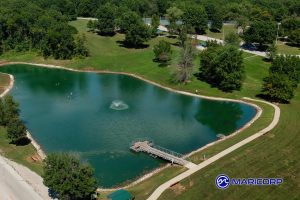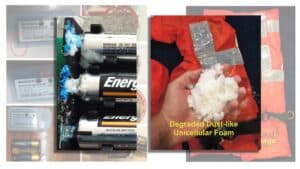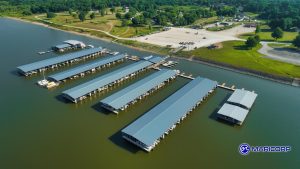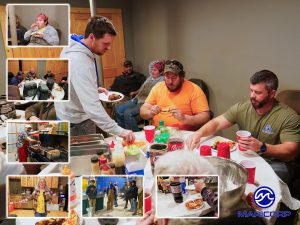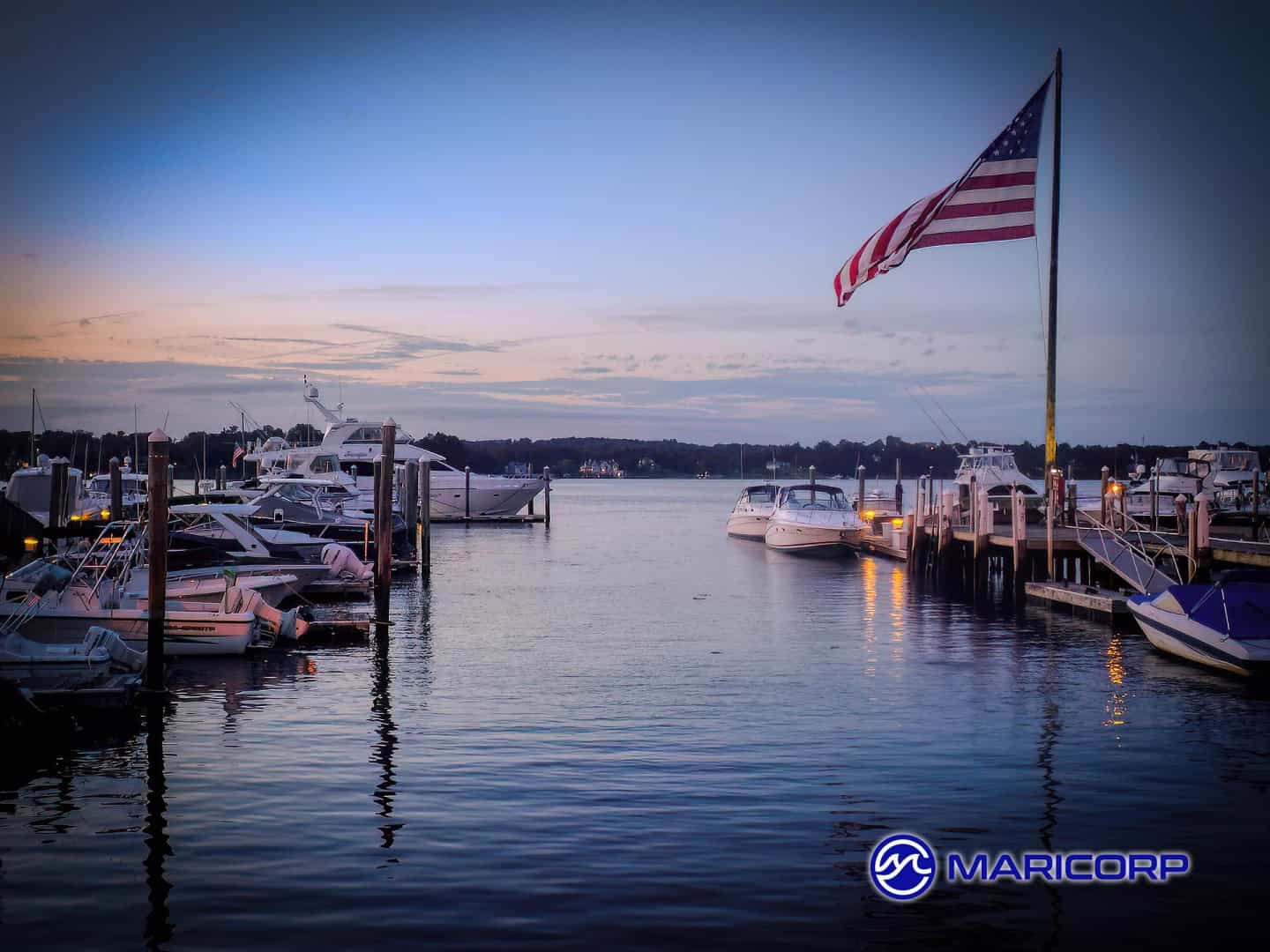Cold Weather Dock Safety
Cold weather dock safety becomes a real issue the moment temperatures dip toward freezing, not just after the water ices over. Slips, walkways, service floats, gangways, and fuel docks all change character in late fall. Surfaces that felt fine in October can turn slick overnight. Lines stiffen. Hose fittings crack. Power cables get brittle and sit where someone can trip. Your team is also working in heavier gear and reduced daylight, which means slower movement and less visibility. Cold weather dock safety is about getting ahead of those changes before the first true hard freeze, instead of reacting after you already have a problem.
Set the tone early with staff. Every walkthrough at the start and end of a shift should now include a cold weather dock safety check, just like you’d do a fuel spill kit check in summer. Ask for anything that looks off, not just hazards that are obvious. “The cleats on C dock feel slick.” “The north ramp felt steeper tonight because of frost.” “The light under the fish cleaning table is out.” The goal is for staff to treat cold weather dock safety like a standing job responsibility, not a special project.
From the boater side, this is also the time to start coaching people about slower movement. You don’t want to insult anybody’s ability. You do want to say, “After dark, please use the handrails and keep one hand free.” That kind of simple language lands well, and you can print it on a half-sheet at the office window.
Ice Watch Checklist: First Freeze Hazards to Monitor
Ice watch is not only about actual ice sheets. Ice watch is about logging where frost, thin glaze, pooled water, or snow melt will show up first so you can act fast. Treat it like an early warning map.
Build an ice watch checklist that includes:
High shade zones. Any dock finger or ramp that almost never sees direct sun in November or December will freeze first. Mark those finger letters or slip ranges on your sheet.
Wind fetch and spray zones. Anywhere heavy north or west wind throws spray up onto a deck or gangway can flash-freeze even if the air is just above freezing. Note which approach lanes or exposed corners do this.
Known low spots. If one corner of the fuel dock always puddles after rain, assume that puddle will become a thin skating rink. Add it to the ice watch checklist and flag it with a cone or temporary mat.
Power and water points. Any pedestal or spigot that drips onto the walking surface needs to be wrapped, tightened, or temporarily blocked off. If you see ice forming under a pedestal, cordon that area and log it.
Gangways. Gangways concentrate traffic. If frost forms there first, that is your number one slip-and-fall risk. The ice watch checklist should have a yes/no prompt for “frost on gangway rails” and “frost underfoot,” every morning and every evening.
Document what you find at opening and again after sunset. Keep that log at the counter, not buried in someone’s email. When something trends (for example, “North end of B dock is slick three nights in a row”), you now have proof to justify action, whether that is temporary signage, mats, salt alternative, a handrail repair, or closing that finger after dark.
Lighting, Visibility, and Signage After Dark
Cold weather dock safety changes the minute daylight drops off. Winter dock safety depends on being able to see hazards before you step on them. That starts with lighting.
Walk every main path, ramp, and gangway after sunset, not at noon. Note burned bulbs, weak fixtures, flickering photocells, and dark corners where staff or slip holders still have to pass. Anywhere you cannot clearly see the next three deck boards in front of you is a problem. Prioritize quick fixes in high traffic zones first: the fuel dock, the main gangway, and any common bathhouse or office access.
Add temporary, high contrast markings in key spots. Reflective tape on the first and last riser of a ramp. A brightly colored strip at the gangway hinge. A simple “Use Handrail” sign at the top of any ramp that frosts. Winter dock safety is about giving people visual cues in cold conditions when they are carrying gear, wearing gloves, and not moving as fast as they would mid season.
You also want clear “No Unauthorized Access After Dark” or “Staff Only Beyond This Point” signs on any dock finger that you know ices first. Closing a high risk span overnight is better than letting someone wander onto a slick, unsupervised surface. If you do close a finger or a section, log the time and reason. That written note matters if you ever have to explain how you managed cold weather dock safety.
PPE, Slip and Fall Response, and Staff Safety
Winter dock safety has to protect the people who work the property, not just boat owners. Issue basic cold weather dock safety gear to anyone walking docks on shift: non slip footwear or slip on ice cleats, a mid layer that still allows full movement, a headlamp, and gloves with grip that still let them handle lines or open a pedestal door. Make sure every person on duty carries a radio or phone in a secure pocket, not in a hand, so they can keep one hand free for the handrail.
Set a simple rule. Nobody goes alone to respond to anything on an icy or suspect surface. Even if it is just checking a line slap or a tripped breaker, send two people and have one stay on stable footing while the other steps onto the questionable area. That protects the employee, and it also means that if there is a slip you already have a witness and immediate help.
Write out the first five minutes of a fall response and post it at the counter. Step one: do not move the injured person unless they are in direct danger. Step two: call emergency services if there is any sign of a head strike, back pain, or loss of consciousness. Step three: station one staffer to guide responders from the parking lot to the exact dock location. Step four: take two quick photos of the surface where the slip happened, and note temperature, time, and lighting conditions. This is not about blame. This is about documenting that cold weather dock safety and winter dock safety were being actively managed.
Finally, have a warm recovery area ready. A bench, a blanket, and water inside the office or store make a huge difference. You do not want the first place an injured guest sits to be on a cold dock box in the wind.
Handrails, Ladders, and Access Control
Cold weather dock safety also means controlling how people move, not just warning them. Start with handrails. Any main gangway, fuel dock approach, or high-traffic ramp should have a solid, continuous rail that can be used with a gloved hand. If a section is loose, flexes, or has play at the post connection, fix it now instead of waiting for spring. Winter dock safety depends on stable grab points because footing will fail before the rail does.
Check every fixed ladder, dock ladder, and emergency retrieval ladder. Make sure rungs are free of algae and ice buildup and the attachment hardware is still tight. If any ladder is seasonal and normally pulled for the winter, confirm that you’re not leaving an obvious climb point missing in an area you’re still inviting people to use. If a ladder is unsafe, don’t just note it. Bag it off, tag it “Do Not Use,” and update your site map so staff know the next closest retrieval point.
Limit casual traffic. It’s reasonable in winter to say “authorized access only past this point after dark” on certain fingers or work floats. That’s not you being unfriendly. That’s you controlling liability. Post the message where people have to make a decision, not hidden at the dock head. Reinforce it with lighting and reflective tape so nobody can claim they “didn’t realize” they’d walked into a closed zone. Good winter dock safety sometimes means restricting movement and documenting that restriction in writing.
Power Pedestals, Hoses, and Trip Risks
As temperatures swing around freezing, cords stiffen, water lines leak, and anything left across a path becomes an ankle trap. Cold weather dock safety calls for a clean deck: no loose cords, no spare dock lines snaking across a shared walkway, no winterizing hoses left underfoot.
Make pedestal checks part of the daily ice watch. Look for:
• Drip points that pool and refreeze at the base of the pedestal.
• Ground-fault trips or scorched outlets that suggest somebody tried to run a space heater they shouldn’t.
• Power cords running across shared walking surfaces instead of being routed cleanly along the finger edge.
For hoses, drain and coil them so they are not freezing in a loop where people step. If you have a known leak, shut that bib down and post a small “Water Off for Winter” tag instead of letting it ice the deck every night. Winter dock safety is easier to defend when you can show you took a slip hazard out of service instead of letting it keep creating new ice.
Close with this rule for staff: if you see something on the deck that could trip you in the dark while wearing gloves and carrying a pail, move it now. Don’t wait for “the next round.” Quick correction is part of your documented cold weather dock safety program.
Ice Watch Logging and Response
Ice watch is not guesswork. Treat it like a standing log the same way you would track pumpout maintenance or fuel dock inspections. Build a simple sheet (clipboard at the counter or shared tablet) with these fields: date, time (morning / after dark), air temp, wind direction, any frost or thin ice observed, and action taken.
Key prompts to include:
• Gangways: “Frost underfoot?” “Handrail icy?”
• Fuel dock: “Puddling / glaze present?”
• North or shaded fingers: “Deck slick?”
• Pedestal bases: “Ice ring forming?”
• Access ramps: “Signage in place?”
• Closed zones: “Markers still up and visible?”
Any “yes” answer should trigger a same-shift correction. Lay down a temporary nonskid mat, post a cone, wipe frost from a handrail, or temporarily block access. Winter dock safety depends on speed. You’re not writing the log for paperwork only. You’re using it to decide if a dock finger needs to be closed for the night, or if a warning sign needs to move because the risk moved.
If something repeats — for example, “east gangway is slick every night when temps hit 33 and wind is out of the north” — escalate it. Escalation can mean re-aiming a light, adding a nonskid surface, or formally restricting access after sunset. Cold weather dock safety is much easier to defend, internally and externally, when you can point to a pattern you caught early and a decision you made in writing.
When you do close something, note the time you posted the barrier and the time you reopened it. That detail matters if a boater later says they “didn’t know” an area was off limits.
Customer Messaging
The goal is to educate, not scare. You do not want a panic email that sounds like “everything is slick and dangerous.” You want clear winter dock safety expectations that feel like respect.
Use calm, practical phrases:
• “As temperatures drop, docks and gangways can become slick in shaded areas and after dark. Please use handrails, move slowly, and keep one hand free.”
• “Some high-risk areas may be closed at night for your safety. If you see a marker or sign, please do not enter that area.”
• “Need assistance carrying gear? Call the office and we’ll meet you at the gate.”
Print that language and tape it at eye level at the main access point. Put the same wording on your website and in a short email to slip holders before the first freeze. Reinforce it verbally at checkout or fuel: “Watch your footing on B dock after sunset, we’ve had frost there.”
Be specific when you talk to boaters about limits. “C dock outer finger is closed after 6 p.m. because it ices first” is better than “don’t go down there.” Specific, location based guidance supports cold weather dock safety and keeps winter dock safety credible, because it sounds informed, not generic.
Also, remind customers that reporting helps. “If you spot ice or a slick spot, please call the office right away so we can flag it.” That turns boaters into extra eyes instead of untracked risk.
Documentation, Liability, and Freeze Prep
Close the loop with basic documentation. Each day, keep three items in one place:
The ice watch log (morning and after dark notes).
Any closures or restricted access decisions (where, when, who posted it).
Any incident notes (slip and fall, near miss, or “almost went down on the ramp”).
Why this matters: if someone does fall, you can immediately show that winter dock safety and cold weather dock safety were not accidental. You can show that you inspected, flagged, restricted access, and communicated. That protects the marina legally, and it also protects future budgets. A documented pattern (“north gangway slick four nights in a row at 33 degrees, shaded, no sun until 10 a.m.”) justifies a permanent surface upgrade in the spring.
Use those notes to build your freeze playbook. After the first serious cold snap of the season, hold a 15 minute review with the team. Ask three questions:
• Where did we get surprised?
• Where did lighting or signage fall short?
• Where did we get lucky instead of prepared?
Update the access map, the customer notice, and the staffing rule (no solo responses on icy surfaces) based on that review. Save all of it — the log template, the customer notice language, the “use the handrail” sign, and the restricted access map — in a shared folder labeled for winter dock safety. Next year you will not be building this from scratch the night before the first freeze.
Maintain Winter Dock Safety All Season
Cold weather dock safety is not a one-week project at the first freeze. It becomes normal winter dock safety procedure for the rest of the cold season. The goal is to make this repeatable so you are not starting from zero every time the temperature swings or you get a surprise icy morning.
Lock in a few habits now:
• Keep ice watch active until consistent daytime highs are well above freezing. Even one warm spell does not mean you can stand down. Shaded ramps and north facing fingers will still glaze overnight when the air drops again.
• Treat lighting checks like fuel dock checks. “Lights good / lights failed / lights repaired” should be a yes or no prompt on the opening checklist, not a sticky note.
• Refresh signage when it gets sloppy. A soaked paper “Use Handrail” sign taped to a post says “we forgot,” not “we care.” Reprint and rehang so it looks intentional. Clear, professional signage supports cold weather dock safety and reassures slip holders that you have their back.
• Watch staff fatigue. Cold moves slower through you than through bare aluminum, but it still wears people out. Rotate who does dock walks during icy conditions so one person is not always the one out in the worst footing. Winter dock safety depends on alert staff, not exhausted staff.
• Capture photos. Take one clear photo of each closure, each hazard you flag, and each corrective measure (mat placed, cone placed, access blocked). Save them with date and time. Those photos prove action, and they also become training material for next season.
Finally, share the basics with your boaters in plain language. “Here’s how we’re managing slippery docks. Here’s how you can help us keep everyone upright.” That makes the marina look competent instead of alarmed, and it frames cold weather dock safety and winter dock safety as something you’re actively leading, not just reacting to when someone goes down.
Additional resources and reading:
*Sign up for our free newsletter “Marina Management Journal” so you can stay up to date
About MariCorp
Maricorp is one of the largest floating boat dock manufacturing and construction companies in the United States, specializing in galvanized steel floating docks and boat lift systems. With projects spanning coast-to-coast, Maricorp provides marina consultation and design, marine construction, marina repair and renovation, and boat dock disaster response and demolition.





